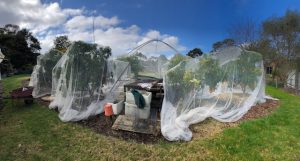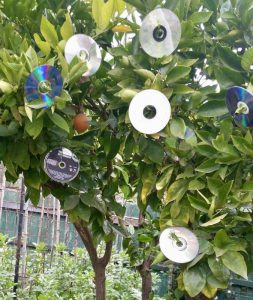Thanks to all the people who have contributed to this week’s newsletter: Angelo Eliades, Carol Woolcock, Cathy Romeo, Chloe Thomson, Chris Kent, Dassana, Deb Thomson, Helen Besley, Jane Dyer, Jo Buckle, Joy Quinn, Lucinda Flynn, Maria Ciavarella, Olwyn Smiley, Pam Jenkins, Rebecca Donald, Rebecca Haschek, Rita Varrasso, Robin-Gale Baker, Sam Dixon, Sean Flynn, Stuart Rodda and Vasundhara Kandpal.
What farmers’ markets will be happening this weekend?
On Saturday: Coburg. Not Abbotsford Convent or Wonga Park.
On Sunday: Alphington and Eltham.
Eltham Farmers’ Market publishes a regular newsletter – sign up here. Melbourne Farmers Markets (who run the Alphington and Coburg farmers’ markets) also publish a regular newsletter – sign up here.
A virtual tour of Pam Jenkins’ orchard
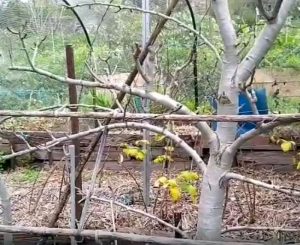 A few weeks ago, we published a video by Pam Jenkins about her annual edible garden. Pam has now produced a video about her orchard. As Pam says in the words accompanying the video, “In permaculture terms, an orchard would be classed as zone 3 or 4. As this area doesn’t need year round daily or even weekly visits for maintenance or pest control, it is situated further away from the house than the annual and perennial gardens that are in zones 1 and 2. General care starts in August when I clear the weeds so that I can see the new season asparagus as it emerges. I also throw around some manure and/or compost then mulch the area to give the trees some slow release food for their spring growth and summer to autumn harvest. This also helps to smother some of the annual weeds.” She then goes on to discussed some of her under-plantings including nasturtiums, perennial leeks, day lilies, parsley and warrigal greens.
A few weeks ago, we published a video by Pam Jenkins about her annual edible garden. Pam has now produced a video about her orchard. As Pam says in the words accompanying the video, “In permaculture terms, an orchard would be classed as zone 3 or 4. As this area doesn’t need year round daily or even weekly visits for maintenance or pest control, it is situated further away from the house than the annual and perennial gardens that are in zones 1 and 2. General care starts in August when I clear the weeds so that I can see the new season asparagus as it emerges. I also throw around some manure and/or compost then mulch the area to give the trees some slow release food for their spring growth and summer to autumn harvest. This also helps to smother some of the annual weeds.” She then goes on to discussed some of her under-plantings including nasturtiums, perennial leeks, day lilies, parsley and warrigal greens.
Vasundhara’s recipes of the month – breads
The theme for Vasundhara Kandpal’s three recipes this month is breads. The three recipes are:
 |
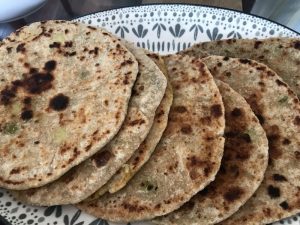 |
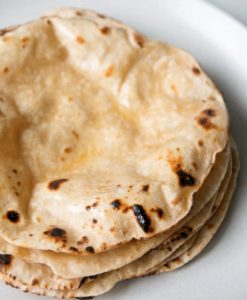 |
| Naan | Pea paratha | Roti |
Like all of Vasundhara’s recipes, the recipes are plant-based.
As I’ve got space, I’m going to put my favourite of the three breads (naan) in full below but you will have to go to the website to read the other two (pea paratha and roti).
Naan
1 cup plain flour
2 teaspoons yeast
1 tablespoon sugar
1 teaspoon salt
oil
warm water, as required for the dough
Combine the warm water and sugar. Sprinkle with the yeast and set aside for 5 minutes until it is foamy.
Mix the salt and flour and knead using the warm water mixture.
Cover and set aside for it to rise until roughly doubled in size (around 1 hour).
Heat a pan / skillet or griddle over medium-high heat. Shape the dough into balls and then roll into round or oval flat bread (an irregular shape is fine so long as the dough is the same thickness across).
Sprinkle some water on one side of the bread and place on the griddle and cook until it bubbles up.
Lift the pan, such that the naked flame is exposed. Cook the uncooked side of the bread until it is golden-brown and lightly charred.
Remove the cooked naan to a plate and paint with oil, preferably with chilli oil to give it a nice golden colour. Alternatively, you can use garlic oil and/or sprinkle with chopped coriander.
Repeat with the remaining dough.
Vasundhara toasts her naan on one side in a pan and on the other side using a naked flame. At my request, she has kindly put together a short video to illustrate the process. As she toasts her roti somewhat differently, she has also put together a second video to illustrate this process.
Read more of Vasundhara’s recipes on our website.
Vasundhara Kandpal is a professional cook who operates a meals delivery service called Green Karma in Briar Hill, Eltham, Eltham North and Montmorency. Read her menu and order.
Not all larvae in fruit are Queensland Fruit Fly
In response to Pam Jenkins’ article last week about her rotting capsicum, Olwyn Smiley has written in: “I also found small grubs in fruit this summer, mainly in chillies, mandarins, tangelos and tomatoes. I kept some of the damaged fruit and waited for the grubs to pupate and become mature flies. It turns out that they were not Queensland Fruit Fly (QFF), but Island Fruit Fly (Dirioxa pornia). Last year I was worried by grubs in my tomatoes, and sent photos to Bron Koll, QFF Coordinator for Yarra Valley Agribusiness, but they turned out to be the larvae of a small beetle. So not all the small, whitish larvae in fruit are QFF, and without expert advice it is quite hard to tell the difference. It is a concern finding grubs in fruit. The best way of getting an accurate ID is to take a good photo and send it to either a QFF expert or to the Amateur Entomology Australia Facebook group.”
Via Chloe Thomson and Deb Thomson, someone from Agriculture Victoria has also weighed in: “From the images I think there’s a possibility it could be something other than QFF. The black jaws are missing and I can’t see a clear tail end in the picture. However, as I can’t be sure, my suggestion is that it is treated as if it could be QFF.”
And the last word goes to Pam herself: “I did some reading after sending the photos and realised that the grubs were probably not QFF. We had a really cold night last week which would probably have killed any remaining QFF anyway. However, it doesn’t hurt to stay alert.”
Yes, you did know! ?
Last week, Doris McAllister asked why she couldn’t collect any worm juice.
Jo Buckle: “There is no ‘juice’ because what’s in the worm farm is dry (e.g. dry leaves). There will only be liquid coming out if the contents are wet (e.g. rotting lettuce). If you want to test that the drainage isn’t blocked, pour some water in and see if it comes out through the tap. Some people think that the ‘juice’ is valuable worm tea, but it’s just seepage from the contents. Worm tea is made from diluting worm castings (the smooth, black finished product after your worms have eaten what’s in the farm).”
Rebecca Haschek: “Worm juice as described by Doris is actually called leachate and is the product of an over-moist worm farm. An over-moist worm farm leads to anaerobic conditions and can actually be a breeding ground for bad bacteria. A healthy worm farm is moist but does not produce leachate … if you take a handful of bedding and squeeze it, it should at most produce one or two drips. Leachate can be used on the garden but, as it is possible for it to have bad bacteria, it is not recommended for edible plants and should certainly be kept away from edible leaves. Having said that, many people who don’t know this use it without a problem. If you want to make worm tea for your edible garden, you can make a worm casting tea bag, then steep it in some aerated water overnight. An old aquarium air bubbler or similar will keep the water aerated and stop any anaerobic activity. Worm tea can be used on edibles as long as they are rinsed thoroughly before consumption.”
“As an aside, sometimes worm farm instructions suggest pouring water through the farm periodically. However, as well as creating leachate, this can make the bedding too moist for the worms and attractive to unwanted creatures such as pot worms and mites.”
Angelo Eliades: “Worm farms only produce leachate when there is excess water. If your warm farms are kept outside, keep the tap open with a bucket underneath. After it rains, there will be a bucket of worm wee to collect. Most fruit and vegies are around 80-90% water so, if you’re adding enough kitchen scraps, there should be excess water and there will be small amounts of leachate draining through into the bottom tray of the worm farm. Using a worm blanket or whole newspaper to cover the food scraps helps retain the moisture and creates a moist, protected environment for the worms to feed in. The bedding material of any worm farm should be as moist as a squeezed out sponge; if it’s drier than that then it will soak up any moisture released.”
Maria Ciavarella: “Winter food scraps tend to be less wet than the scraps that you might supply your worms in the warmer weather. So that’s why there’s less worm wee output in winter. It won’t harm your worms to give them a little shower every now and again and you’ll soon hear the dripping of the leachate going into your liquids’ tray. Do this by using a watering can over the worm blanket covering so as not to shock them instantly! Also, it might be a good idea to lift off the worm trays and see what is happening in the liquid accumulator tray. You might find a lot of castings have made their way into this tray and are blocking the tap.”
Sam Dixon: “I get more worm juice when I very carefully aerate the contents of the worm with my hand trowel. I do this at least once a week.”
Do you know? ?
Dassana: “Last summer, after a blast of heat, all my bean and tomato flowers died and it took ages for them to send out new ones and so for fruit to set. Any tips on managing weather extremes? Also, why do the tops of zucchini flowers sometimes rot?” Email your answers.
Emily Lim: “I am looking for insect/cabbage moth cover or exclusion nets. What type should I get and where should I get it from?” Email your answers.
The Pickle Sisters – readers’ puns
 Last week, we asked for puns to accompany the picture of The Pickle Sisters. We had 5 responses.
Last week, we asked for puns to accompany the picture of The Pickle Sisters. We had 5 responses.
- And now here’s The Pickle Sister’s with their new hit song “You look like a right dill” (Sean Flynn).
- Green Cap-sicums (Helen Besley).
- Is that a cucumber in your pocket or are you just glad to see me? (Sean Flynn).
- Sweet and Sour Pickles (Joy Quinn).
- The Pickle Sisters … Did they do the soundtrack for The Life of Brine? (Sean Flynn).
Another article from Angelo Eliades
What are the small flies in compost bins and are they a problem?. Hint: 1) drosophila and 2) no.
Read more of Angelo’s food-related articles.
Make you own newspaper pots
Maria Ciavarella has produced this video to show you how.
Make your own raspberry root barriers
Stuart Rodda has written in: “I recently created a standalone raspberry bed. However, I faced the dilemma – how to stop them spreading further, and how to stop tree roots invading the bed and sucking all the moisture and nutrients out? A raised bed would be ok but relatively expensive and would need regular watering to prevent drying out.
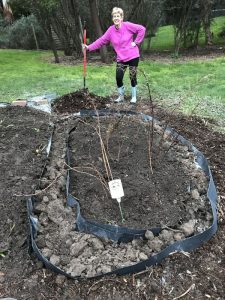 “Root barrier! After researching root barriers on the Internet, I came up with a low cost dual solution: (1) use plastic dampcourse set vertically in the ground encircling the raspberries; and (2) make two concentric barriers and fill the gap between them with clay which would be repellent to roots but not ‘toxic’. As a repellent material, I chose builder’s lime, which is calcium hydroxide, and highly alkaline but otherwise not toxic to plants. My theory is that roots cannot grow through the plastic and any that might grow under or over it will encounter such an alkaline pH that they will cease growing and look elsewhere. I thus dug down and installed the two rings of plastic (40 cm deep), backfilling with the densest clay mixed with builder’s lime (note: not agricultural lime, which is alkaline but not so much so). Total cost approx. $25. I await the results early next year.”
“Root barrier! After researching root barriers on the Internet, I came up with a low cost dual solution: (1) use plastic dampcourse set vertically in the ground encircling the raspberries; and (2) make two concentric barriers and fill the gap between them with clay which would be repellent to roots but not ‘toxic’. As a repellent material, I chose builder’s lime, which is calcium hydroxide, and highly alkaline but otherwise not toxic to plants. My theory is that roots cannot grow through the plastic and any that might grow under or over it will encounter such an alkaline pH that they will cease growing and look elsewhere. I thus dug down and installed the two rings of plastic (40 cm deep), backfilling with the densest clay mixed with builder’s lime (note: not agricultural lime, which is alkaline but not so much so). Total cost approx. $25. I await the results early next year.”
The photo is of Stuart’s wife, Christine.
Re-locating bee swarms
Jane Dyer has written in: “Gardens are waking and bees moving. As winter draws to a close, and day temperatures rise, there will be more action around the beehives. Spring is the time for swarming and a time to have the name of a trusted beekeeper handy who has the skills and facilities to catch and safely re-locate swarms before they settle in an eave or neighbour’s chimney. My husband, Peter Dyer, from Backyard Honey (0425 873 555), has been re-locating swarms in Boroondara, Whitehorse, Banyule and surrounding areas for the last 10 years.”
Here are some local people who collect bee swarms. This list largely comes from The Beekeepers Club. Always ring, rather than text or email, as swarms move on quickly. Also, check to see if they charge for a collection.
| Base | Name | Phone | Notes |
| Box Hill | Peter Rundle | 0457 006 575 | Swarms only |
| Camberwell | John Treloar | 0409 164 234 | Swarms only |
| Diamond Creek, Eltham | Andrew Stanish | 0418 521 869 | Swarms and nests |
| Forest Hill | Adrian O’Hagan | 0408 768 343 | Swarms only |
| Forest Hill | Gavin Preston | 0402 833 228 | Swarms and nests |
| Hawthorn East | Kent Henderson | 0417 599 548 | Swarms only |
| Heidelberg | Mat Lumalasi | 0414 406 136 | Swarms and nests |
| Heidelberg | Justin Brasier | 0407 515 482 | |
| Kinglake | Susan Zuber | 0413 698 140 | Swarms only |
| Manningham | Geoff Neville | 0412 613 135 | Swarms and nests |
| Mitcham | Peter Milic | 0418 340 093 | Swarms only |
| Mitcham | Keith Piper | 9874 8634 | |
| Mooroolbark | Claire Smith | 0425 700 280 | Anywhere from Box Hill to Lilydale; won’t climb ladders |
| Nillumbik | Bryce Copeland | 0484 185 601 | Swarms and some nests |
| Northcote | Morgan Koegel | 0402 496 217 | Swarms only |
| Park Orchards | Stuart Stone | 0408 764 045 | Swarms only |
| Surrey Hills | Peter Dyer | 0425 873 555 | Anywhere from Abbotsford to Templestowe; both bees and swarms |
| Warrandyte | Maureen Koegel | 0425 780 456 | Swarms only |
| Watsonia, Warrandyte & Thomastown | Brad Hales | 0417 549 707 | Swarms and nests |
| Yallambie | Yvonne Ashby | 0409 225 774 | Anywhere within a 20km range |
You can always find this list on the local resources page on our website.
If you find a swarm, but none of the people above can collect it, you can report the swarm on the Swarm Patrol website and it will automatically notify the three nearest bee swarm collectors who are registered with the website.
Guy’s food growing tips – guest contributions
In reaction to me saying that I was running out of topics to give tips about, a number of people have written in with their suggested tips. Thanks everyone!
Carol Woolcock: “When watering your punnets of spring seedlings that you have placed in a polyhouse or on a windowsill, use tepid water not cold water straight from the tap. This will provide consistency of temperature and avoid ‘shock’ to the seedlings.”
Sam Dixon: “To protect delicate seedlings from being eaten by pests, I scrunch up handfuls of rosemary and lavender (to release their pungent oils) and scatter them around the veggie patch. It seems to deter snails, slugs and earwigs.”
Angelo Eliades: “Get your tomato seedlings started early by growing them indoors. Sow your tomato seeds in punnets, trays or small pots now. After watering, cover the tops of the containers loosely with some clear plastic to keep the soil moist while allowing some air circulation. Place the covered container on a drip-proof tray and place that on top of the refrigerator or other warm spot. Place your hand there first to check if it feels warm. Somewhere high up near the ceiling also works well, as heat rises and it will be warmer higher up. A warm sunny window is also good. Make sure that you check every few days to see if the seeds have sprouted because, once they have, the cover needs to come off as they need exposure to sunlight. A spot near a sunny window is then ideal. By the time the early spring frosts pass, the seedlings will be stronger and more advanced.”
Rebecca Donald: “I have recently discovered how fabulous mustard greens are to grow over Winter, especially if you don’t have a lot of space and not great light. I grow quite a few varieties in pots and move them into the light. I used to think they were too spicy but if you don’t like the wasabi-like heat of them fresh, just stir fry or blanch them and it goes away. They are quick growing and you can just pick leaves as you need. A new variety I’ve tried from Diggers called Tokyo Bekana is awesome because it has virtually no mustard taste but is just as easy to grow and, as a bonus, the flowers are good for adding to salads as well. I think you can grow them year round as well for an easy, constant supply of greens.”
Robin Gale-Baker (adapted from a Facebook post): If planting in seed trays, use a seed raising mix if you can, otherwise potting mix, but not garden soil which compacts around seeds. Fill the trays 3/4 full, firm down the soil, water, sprinkle the seed on the damp firm bed, cover with 1cm soil and water again. Keep the soil damp to prevent small seeds drying out. Use a fine spray from a spray bottle, watering can or hose (heavy watering can wash seeds out). If using old seed trays, scrub out, rinse, then soak for 1 hour in 90% water 10% vinegar (any kind) to kill pathogens in the old soil.
Anyone else got any growing tips? Email me.
Meg’s social isolation week
Today the chickens laid their first egg in over 2 months. It is small and beautifully brown coloured. I decide to spoil my layers with a clean out of the coop and fresh new straw. I pull some weeds (mainly chickweed) and leave them in the run for the chooks to scratch.
It is time to start preparing beds for spring/ summer planting. As always, I have planted too much over winter and now have to consider what to sacrifice to make way for a tomato bed. I think that the rocket can finally go – it gets very peppery towards the end and is on the cusp of going to seed. The cleanings from the chook house (old straw and manure) get dug lightly into the bed and now it needs to rest until we get that spring warmth.
What to do with all that rocket? Pesto? Tabbouleh?
Rocket tabbouleh
3 cups of rocket leaves
¼ cup (or small handful) mint leaves
1 small red onion or 2-3 shallots, very finely diced
3 tomatoes, finely diced
¼ cup bulgur/ cracked wheat (pre-soaked and prepared in accordance with packet directions), drain well and squeeze out excess water
1 tablespoon lemon juice
olive oil, salt and pepper to taste
Finely chop the rocket and mint leaves.
Add the onion, tomatoes, lemon and bulgur and combine well.
Leave for about 1 hour then toss and dress with olive oil, salt and pepper.
Reader photos
Last week’s theme – animal deterrents
5 photos were submitted, 3 in a series by Cathy Romeo.
This week’s theme – wattle flowers
This week’s photo theme will be ‘wattle flowers’ As ever, send me your interesting photos. Make sure that you state which wattle species it is, preferably including the Latin.
Which link was clicked most times in the last newsletter?
Joke of the week
What do you get when you cross a cat and a lemon? A sour puss.
Upcoming online events
If you know of any events other than those listed below, email me.
Newly announced events
Composting and worm farming at home: Saturday, 29th August, 10.30am-midday; free; organised by Boroondara Council. Read more and book on EventBrite.
Beginners guide to pruning: Saturday, 29th August, 2-4pm; $50; organised by CERES. Read more and book on Humanitix.
Soils and potting media: Monday, 31st August, 3.30-5.30pm; $50; organised by CERES. Read more and book on Humanitix.
Zero waste cooking – easy pickling: Friday, 4th September, 1-2pm; free; organised by Boroondara Council. Read more and book on EventBrite.
Herbs for kitchen and garden: Saturday, 5th September, 2-4pm; $50; organised by CERES. Read more and book on Humanitix.
Butter chicken: Sunday, 6th September, 11.30am-1pm; $29; organised by Cook Indian by the Creek. Read more and book via Facebook.
Complete guide to home composting: Saturday, 12th September, 2-4pm; $50; organised by CERES. Read more and book on Humanitix.
Previously announced events
Advanced home composting and worm farming: Wednesday, 19th August, 7-9pm; free; organised by Manningham Council. Read more and book on EventBrite.
Sourdough bread making: 4 occurrences – 22nd August 10-11am, 23rd August 2-3pm, 12th September 11am-midday and 13th September 3-4pm; $20; organised by Living & Learning Nillumbik. Read more and book on their website.
Edible weeds walk: Saturday, 22nd August, 11am-1pm; $28; organised by Very Edible Gardens. Read more and book on their website.
Authentic Indian cookery in Thermomix: Saturday, 22nd August, 2-3pm; free; organised by Sharyn Vanderhorst. Read more and book on EventBrite.
Introduction to brewing and fermenting: Saturday, 22nd August, 2-4.15pm; $28; organised by MYCOmmunity. Read more and book on their website.
Zero waste cooking and sustainability: 7 sessions, on Tuesdays, starting 25th August, each 10am-1.30pm; free; organised by Jesuit Community College. Read more and book on WeTeachMe.
Social gardening for Manningham residents: Tuesday 25th August, Tuesday 8th September and Tuesday 22nd September, each 1.30-2pm; free; organised by Kevin Heinze Grow. Book by either phone (9848 3695) or email.
Explore our food systems: Thursday, 27th August, 12.30-1.15pm; $0-20; organised by CERES. Read more and book on Humanitix.
Intro to growing nutrient dense food: Thursday, 27th August, 7-9pm; $50; organised by CERES. Read more and book on Humanitix.
Grow into Spring: Saturday, 29th August, 10am-midday; $50; organised by CERES. Read more and book on Humanitix.
Mycocycling cultivation on household waste: Saturday, 29th August, 1.45-3.30pm; $28; organised by MYCOmmunity. Read more and book on their website.
Darebin seed saver champion training with Kat Lavers: Saturday, 29th August, 2-4pm; free; organised by Darebin Council. Read more and book on EventBrite.
Nutrition for families: Saturday, 29th August, 2.30-4pm; $16; Central Ringwood Community Centre.
Rogan josh: Saturday, 29th August, 5-7pm; $35; organised by Cook Indian by the Creek. Read more and book via Facebook.
Open Table offer their weekly no waste cook club workshops free and online on Saturdays. As well as cooking (which is actually optional), you will learn about food waste and composting. Register on EventBrite.
Pip Magazine (some of whose journalists live in North East Melbourne) are producing a series of videos entitled simple skills for self sufficiency.
All The Dirt is a weekly podcast about gardening.




